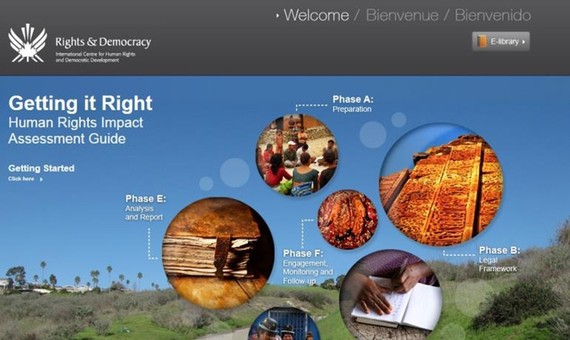Co-authored by Sarah Zoen, Senior Advisor, Private Sector Department at Oxfam America.
Numerous companies, non-governmental organizations (NGOs) and human rights practitioners have conducted human rights impact assessments in recent years. For instance, in 2012 Kuoni partnered with TwentyFifty Limited and Tourism Concern to assess its human rights impacts in Kenya. More recently, NomoGaia piloted a tool for evaluating the human rights implications of the Disi Water Conveyance Project in Jordan.
A Human Rights Impact Assessment (HRIA) is a process that identifies the potential and actual human rights impacts of a corporate project and recommends how to prevent, mitigate and/or address these impacts. HRIAs are different from Environmental Impact Assessments because of their holistic approach. Based on the inter-relatedness and indivisibility of human rights, they cover both environmental and social issues. HRIAs are different from Social Impact Assessments because their standards are anchored in binding national and international legal frameworks. This is important because these frameworks clearly identify duty-bearers and rights-holders.
The advent of HRIAs has triggered long conversations, numerous events and interesting reports on how to best conduct them. The Danish Institute for Human Rights recently published a useful toolkit in this respect.
The attention to the topic is welcome, and many reports do include valuable suggestions. Yet, most of these documents miss a crucial point: It is often more important to discuss who should lead the human rights impact assessment, rather than dispute on how the assessment should be conducted.
The "who" question is fundamental for several reasons. We highlight three of them here below.
First, the "who" question is important because the production/selection of business and human rights indicators is not a "technical" but a "political" exercise
More often than not, the process of producing/selecting indicators is not about defining what is "correct" but about defining what is "important". If this is the case, basic human rights principles require active empowerment of, and participation from, affected individuals.
For example, HRIAs should concentrate on safeguarding the rights and interest of affected communities. However, they often focus excessively on managing the risks for the company.
The importance of this point becomes even clearer once one realizes that human rights-friendly experts themselves often disagree on the importance of some human rights vis-à-vis other human rights. For instance, is it worse to have a few big impacts or numerous small impacts? There is no consensus.
Human rights serve the purpose of empowering people to influence the decisions that affect them, not empowering human rights experts to decide what is best and what is worst. Rights holders should never be conceived as a means to an end but should always stand at the centre of HRIAs.
Second, the "who" question is important because human rights impact assessments should be the basis for real action
Companies, NGOs and human rights practitioners do not conduct human rights impact assessments for the sake of themselves. At least in principle, they assess human rights impacts in order to prevent, mitigate or redress them.
Human rights impact assessments should therefore be "owned" by those who need to act upon them, that is, all interested stakeholders (in general terms, the company, the local and national governments and the local communities). Ownership is crucial to ensure legitimacy, consent, and, consequently, follow-up.
For instance, community-led human rights impact assessments often address issues that are neglected by other processes. Yet, there needs to be a process by which these findings are also "owned" and internalized by those who have the power (not always the right) to change things. Valid evidence is useless if left ignored.
Third, the "who" question is important because human rights impact assessments have strong potential as capacity-building tools
Let us face it. In most cases, none of the actors involved in business projects operating in remote regions have ever heard about human rights. Not the engineers who lead the business plan. Not the indigenous communities on whose lands the project is expected to operate. Not the local government officials who are supposed to regulate the way in which the project is conducted.
An HRIA can instil awareness and knowledge of human rights among all these actors. And this ensures that human rights become part of their lexicon and normal way of operating.
One of the biggest promises of HRIAs is that they provide companies and communities with the tools to assess and address human rights impact even after they have been concluded.
One possible way forward? Hybrid human rights impact assessments
The good news is that a few organizations have started to address the "who" question.
In 2004, the Canadian organization Rights & Democracy developed Getting it Right, the first-ever community-based HRIA tool. The tool's methodology puts affected communities in the driver's seat to assess and document the potential human rights impacts that investment projects may generate.

Homepage of "Getting it Right" (http://hria.equalit.ie/en/)
Building on this vanguard work, the International Federation for Human Rights (FIDH), Oxfam, the Project on Organizing, Development, Education, and Research (PODER), and the Carter Center have been promoting active leadership from local communities in measuring the human rights impacts of business projects.
While maintaining its support to community-based HRIAs, in a recent report Oxfam proposed the idea to further embed meaningful human rights due diligence processes within companies or local governments. The idea is to explore a parallel or hybrid HRIA process from the start as a way to prevent adverse impacts on communities before they even begin to surface.
Oxfam recognizes that community-based HRIAs will always be necessary to counter company projects where business executives simply refuse to engage communities in a proper process. However, where there are opportunities for companies and communities to co-own an HRIA process there is greater likelihood that companies, and even governments, would take action to address the recommendations.
A methodology has not been tested yet, and the "Wild West" of HRIAs is still reigning among the organizations working in the field. Our position is to advocate for further work in this area.
The practicalities of hybrid human rights impact assessments are challenging (from redressing power imbalances to including legitimate mediation, from ensuring independent funding to empowering communities to say no to harmful projects). Yet, the approach looks promising.
It looks promising because it addresses a neglected but fundamental question in the business and human rights community. Who measures human rights?

